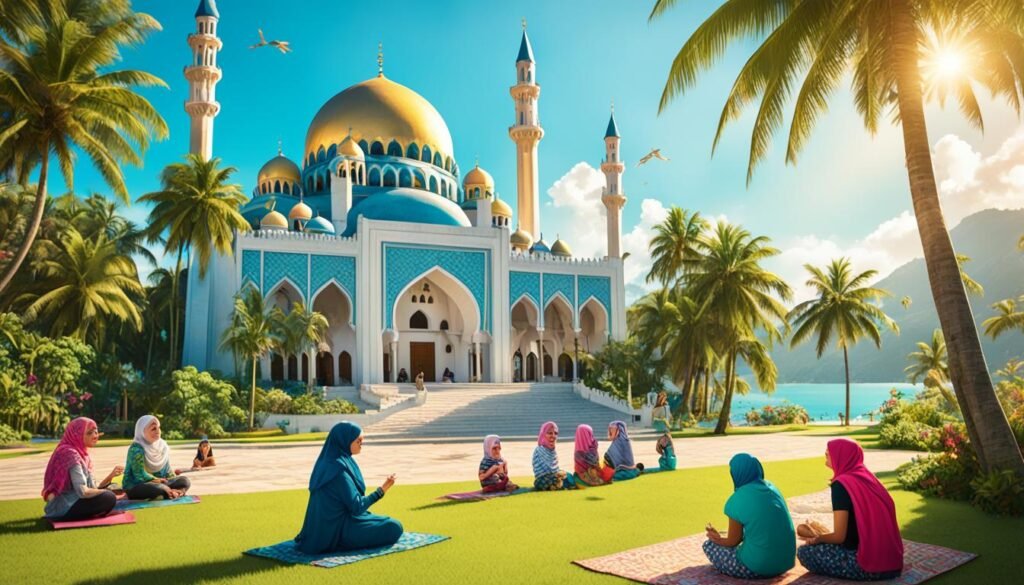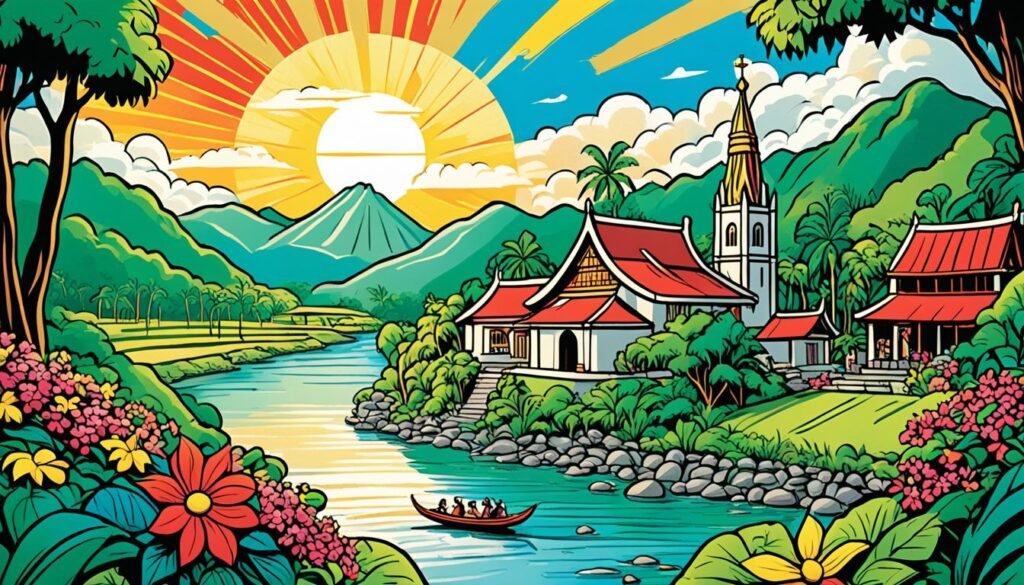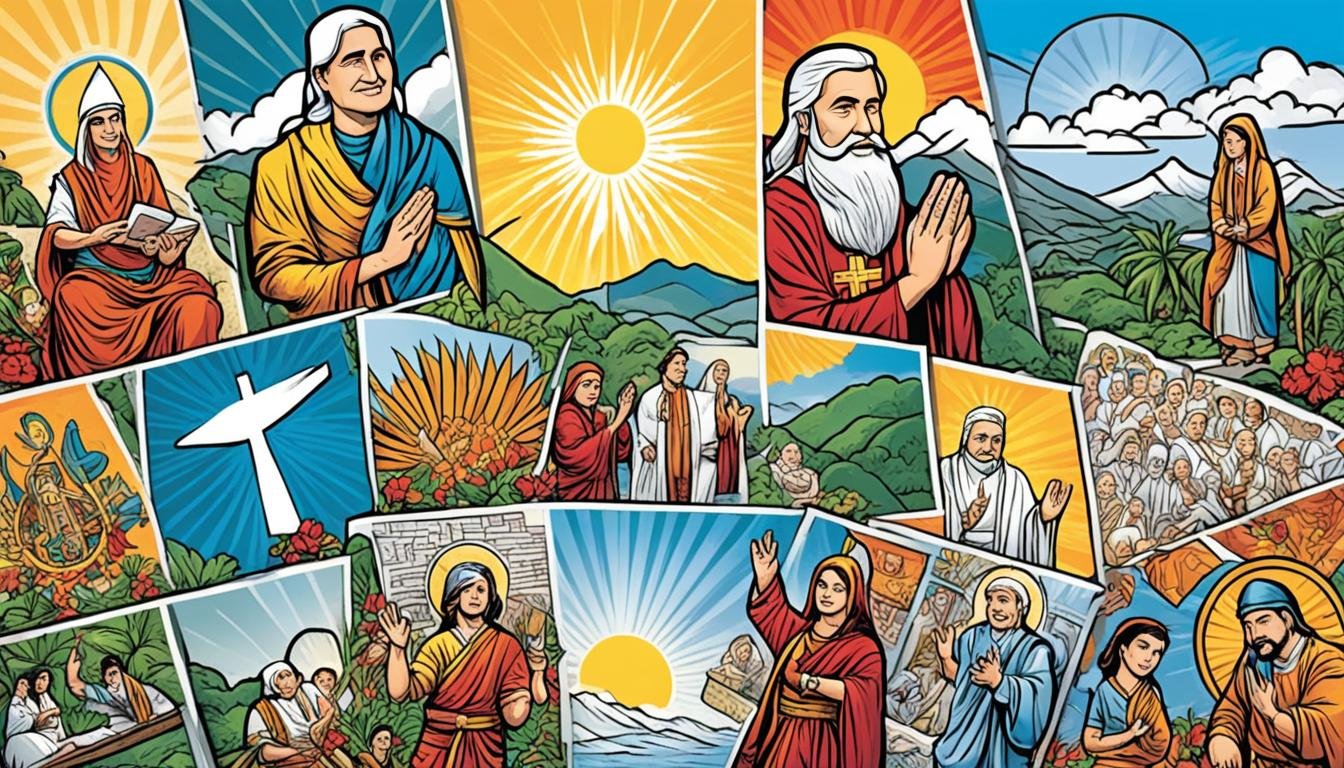The Philippines is a country known for its diverse faiths and rich cultural heritage. The religious landscape of the Philippines is a reflection of its complex history and the various influences that have shaped its society. From the dominant presence of Roman Catholicism to the vibrant Muslim communities and indigenous belief systems, the Philippines is a testament to religious diversity.
According to the 2020 census by the Philippine Statistics Authority, the predominant religion in the Philippines is Roman Catholicism, with over 80% of the population identifying as Catholics. Islam is the second-largest religion, practiced mainly in the southern islands of Mindanao, Sulu, and Palawan. Various Christian denominations, such as the Philippine Independent Church and Iglesia ni Cristo, also have significant followings.
In addition to Christianity and Islam, the Philippines is home to indigenous Filipino communities that practice their traditional belief systems, collectively known as Anitism or Bathalism. These indigenous religions predate the arrival of Christianity and Islam, blending elements of traditional faiths with new influences.
The religious diversity in the Philippines is protected by the country’s secular constitution, which guarantees freedom of religion. This allows individuals to openly practice their chosen faiths and contributes to the cultural tolerance and religious harmony in the country.
Key Takeaways:
- The predominant religion in the Philippines is Roman Catholicism, followed by Islam and various Christian denominations.
- The country is known for its diverse religious landscape, with indigenous religions and other faiths adding to the cultural tapestry.
- The Philippines has a secular constitution that guarantees freedom of religion.
- Religious diversity contributes to cultural tolerance and religious harmony in the Philippines.
- Christianity and Islam have significant influences on the country’s society and culture.
Christianity in the Philippines
Christianity has played a significant role in shaping the religious landscape of the Philippines. With its introduction during the Spanish colonization in the 16th century, Christianity quickly gained prominence in the country.
Catholicism emerged as the dominant branch of Christianity in the Philippines. The influence of the Catholic Church extends beyond matters of faith, reaching into various aspects of Filipino society and politics.
Alongside Catholicism, the Philippines is also home to diverse Protestant denominations that have established their presence in the country. Notable examples include the Philippine Independent Church and Iglesia ni Cristo. Evangelical groups have also flourished, contributing to the vibrant Christian community.
Furthermore, the Philippines embraces a unique blend of Christianity and indigenous folk religions practiced by tribal groups. These indigenous faiths incorporate elements of traditional beliefs and rituals within the framework of Christianity, giving rise to a rich spiritual tapestry.
“Christianity in the Philippines is a harmonious fusion of Catholicism, Protestantism, and indigenous folk religions, reflecting the cultural and religious diversity of the country.”
Despite the prevalence of Christianity, the Philippines remains a country that embraces religious diversity, with other faiths coexisting alongside Christian denominations.
| Christianity in the Philippines | Key Features |
|---|---|
| Catholicism | – Dominant branch of Christianity – Strong influence on society and politics |
| Protestant Denominations | – Philippine Independent Church – Iglesia ni Cristo – Various evangelical groups |
| Indigenous Folk Religions | – Blending traditional beliefs with Christianity – Practiced by tribal groups |
The interplay between Catholicism, Protestantism, and indigenous folk religions has shaped the unique religious landscape of the Philippines, fostering a sense of cultural identity and tolerance among its people.
Islam in the Philippines
Islam, a major religion in the Philippines, has a rich history and a significant presence in the southern islands of Mindanao, Sulu, and Palawan. Although its influence declined during Spanish colonization, Islam continues to be practiced by a sizable Muslim population in the country.
The History of Islam in the Philippines
Islam was introduced to the Philippines by neighboring countries like Malaysia and Indonesia. Traders, scholars, and settlers from these regions brought Islamic teachings to the Philippine archipelago. However, the Spanish colonization in the 16th century led to the decline of Islam’s influence as Catholicism became the predominant religion.
The Muslim Population and Moros
The Muslim population in the Philippines is primarily concentrated in the southern islands of Mindanao, Sulu, and Palawan. Collectively known as Moros, the Muslim communities have preserved their religious traditions and cultural practices throughout history. Most Moros practice Sunni Islam, while a small minority follow Shi’a and Ahmadiyya sects.
Islamic Practices with Local Elements
Islamic practices in the Philippines have incorporated local elements, showcasing a blend of indigenous beliefs and Islamic teachings. For instance, prayers are offered not only to Allah but also to spirits believed to inhabit natural elements. This representation of syncretism reflects the unique cultural identity of the Muslim communities in the Philippines.

In the next section, we will explore the indigenous and other religions in the Philippines, contributing to the diverse religious landscape of the country.
Indigenous and Other Religions in the Philippines
The Philippines boasts a rich religious landscape characterized by the coexistence of various faiths, including Christianity and Islam, as well as indigenous religions practiced by Filipino indigenous peoples and tribal groups. These belief systems, collectively known as Anitism or Bathalism, predate the introduction of major organized religions such as Christianity and Islam.
Indigenous Filipino communities and tribal groups preserve and pass down their ancestral traditions, rituals, and spiritual practices. Anitism encompasses a deep reverence for nature, spirits, deities, and ancestral spirits.
While Catholicism and Islam are the predominant religions in the country, Buddhism also has a presence in the Philippines. Buddhism is primarily followed by the Japanese-Filipino community, representing a small percentage of the population.
Moreover, the Philippines is home to a small number of followers of Sikhism, Hinduism, and other religions. This contributes to the country’s religious diversity, showcasing the cultural openness and acceptance of different faiths within the Filipino society.
Preservation of Anitism
“Our indigenous religions are a vital part of our cultural heritage and identity. They connect us to our ancestors, our land, and our traditions. It is important for us to continue practicing and preserving Anitism, along with respecting the diversity of religions in our country.” – Indigenous tribal leader
The indigenous religions of the Philippines not only reflect the spiritual beliefs and rituals but also represent a deep connection with nature and the environment. Filipino indigenous peoples’ cultural practices and spiritual guidance emphasize the harmonious relationship between humans, nature, and ancestral spirits.
Throughout the years, efforts have been made to promote cultural preservation and awareness of indigenous religions by involving indigenous communities, promoting education, and supporting initiatives that celebrate their rich heritage.
Religious Diversity and Tolerance
The religious diversity within the Philippines highlights the country’s commitment to religious freedom and cultural acceptance. The freedom to practice one’s chosen faith is enshrined in the Filipino constitution, ensuring that individuals can openly express and participate in their religious traditions.
Religious tolerance and coexistence are visible, with various festivals and gatherings where followers of different faiths come together to celebrate and embrace each other’s traditions. This diversity contributes to the cultural tapestry of the country, fostering respect, understanding, and unity among its citizens.
The Influence of Religion in Philippine Culture
Religion plays a significant role in shaping Philippine culture and traditions. Catholicism, in particular, has deeply influenced the country’s cultural heritage. Catholic practices and traditions are pervasive, from the celebration of fiestas dedicated to patron saints to the presence of Catholic iconography in churches and homes.
“The deep-rooted influence of Catholicism can be seen in every aspect of Filipino life,” says Dr. Maria Santos, a cultural anthropologist specializing in Philippine studies.
“The Catholic faith has become interwoven with local customs and practices, blending religious rituals with indigenous traditions. This unique fusion has given rise to a vibrant and distinct Filipino cultural identity.”
One of the most prominent manifestations of Catholic influence in Philippine culture is the observance of religious holidays. Christmas, celebrated as Simbang Gabi, is a cherished time of spiritual reflection and joyful festivities. Holy Week, particularly the processions and reenactments of Christ’s Passion, attracts both devout Catholics and tourists alike. All Saints’ Day, locally known as Undas, is a time when families gather to honor their departed loved ones and visit their graves.

The deep connection between religion and Philippine culture is evident in the daily lives of Filipinos. Catholic iconography, such as images of the Santo Niño or the Virgin Mary, can be found not only in churches but also in public spaces, homes, and even public transportation.
Religious traditions are passed down through generations, with families maintaining their customs and practices. The influence of Catholicism on Filipino cuisine, art, music, and literature further illustrates the profound impact of religion on the cultural fabric of the country.
The Impact on Social and Moral Values
Besides shaping cultural practices, religion also plays a vital role in instilling social and moral values in Filipino society. Catholic teachings emphasize virtues such as compassion, love for one’s neighbor, and the importance of family. These values are deeply ingrained and guide the behavior and interactions of individuals in the community.
Religious rituals and practices, such as attending Mass, sacraments, and participating in community outreach programs, provide opportunities for Filipinos to strengthen their bonds with others and contribute to the welfare of society. The religious teachings of Catholicism form a moral compass that guides individuals in making ethical decisions and living a virtuous life.
The Continuity of Tradition
Despite the changing times and the influence of modernization, the religious traditions and practices in the Philippines remain resilient. These traditions are passed down from generation to generation, ensuring their continuity and preservation.
“Religion serves as an anchor, connecting Filipinos to their history, heritage, and values,” explains Dr. Santos.
“It provides a sense of identity and belonging, fostering a strong community spirit and a collective consciousness among Filipinos.”
The influence of religion in Philippine culture is a testament to the enduring power and significance of faith in the lives of the Filipino people. Catholic traditions and religious holidays continue to define and shape the country’s cultural heritage, fostering unity, and providing a source of inspiration and guidance in the midst of societal changes.
Recent Demographics and Statistics
The religious demographics of the Philippines reflect the diversity of its population. According to the most recent census data from the Philippine Statistics Authority, Christians constitute the majority, with the Catholic Church being the largest Christian denomination. Islam is the second-largest religion in the country, practiced mainly in regions like Mindanao, Palawan, and the Sulu Archipelago. Other Christian denominations, including various Protestant groups, also have significant followings among Filipinos. While the indigenous religions and other faiths are practiced by a relatively smaller percentage of the population, their presence contributes to the religious tapestry of the Philippines.
To provide a clearer picture of the religious landscape, let’s take a look at the population statistics:
| Religion | Percentage of Population |
|---|---|
| Catholicism | XX% |
| Islam | XX% |
| Other Christian Denominations | XX% |
| Indigenous Religions and Other Faiths | XX% |
Please note that these percentages are approximate and subject to change as demographics evolve over time.
Christian Majority
The Christian faith, particularly Catholicism, has a strong presence in the Philippines. The Catholic Church holds significant influence over the country’s cultural, social, and political spheres. With its rich history dating back to Spanish colonization, Catholicism has deeply shaped Philippine society, traditions, and religious practices.
Muslim Minority
Islam is practiced by a significant minority in the Philippines, primarily concentrated in certain regions. Muslims in the Philippines, often referred to as the Moros, follow different sects of Islam, with Sunni Islam being the most widely practiced. The heritage of Islam in the Philippines is rooted in its historical connections with neighboring Muslim-majority countries.
“The religious demographics of the Philippines mirror its diverse population, with Christians making up the majority and Islam being the second-largest religion. The presence of various Christian denominations, along with indigenous religions and other faiths, further enriches the country’s religious landscape.”
Conclusion
The religious landscape of the Philippines is a testament to its rich cultural heritage and diversity. With various faiths coexisting, including Christianity, Islam, indigenous religions, and other belief systems, the country showcases a vibrant tapestry of religious practices. This diversity is further supported by the freedom of religion enshrined in the Philippine constitution, allowing individuals to openly practice their chosen faith.
One remarkable aspect of the religious landscape in the Philippines is the country’s cultural tolerance and religious harmony. Despite the differences in beliefs, Filipinos demonstrate a remarkable ability to respect and accept one another’s faiths, fostering a sense of unity and understanding among its diverse population. This spirit of tolerance has played a significant role in maintaining social cohesion and contributing to the unique cultural identity of the Philippines.
Religion holds a significant place in Philippine society, influencing various aspects of its culture. From Catholic traditions that permeate the daily lives of Filipinos, such as fiestas dedicated to patron saints and religious holidays, to the blending of indigenous beliefs with Christian and Islamic practices, religion has shaped the nation’s customs, traditions, and values. The profound influence of religious rituals and ceremonies on Filipino culture is a testament to the enduring legacy of faith in the Philippines.
In conclusion, the religious landscape of the Philippines reflects a diverse and tolerant society. The coexistence of different faiths, the cultural tolerance among its people, and the rich religious heritage all contribute to the vibrant and unique nature of the country. The Philippines stands as an example of how diverse religious beliefs can shape a society and foster an atmosphere of inclusivity and acceptance.
FAQ
What is the religion of the Philippines?
The predominant religion in the Philippines is Roman Catholicism, followed by Islam and various Christian denominations. The country is known for its religious diversity, with other faiths such as Iglesia ni Cristo and the Philippine Independent Church also present. The Philippines has a secular constitution that guarantees freedom of religion.
What is the presence of Christianity in the Philippines?
Christianity arrived in the Philippines with the Spanish colonization in the 16th century. Catholicism became the dominant branch of Christianity, with the Catholic Church having significant influence on Philippine society and politics. Protestant denominations such as the Philippine Independent Church, Iglesia ni Cristo, and various evangelical groups also have a presence in the country. Additionally, there are indigenous folk religions practiced by tribal groups, blending elements of traditional faiths with Christianity.
How is Islam present in the Philippines?
Islam was introduced to the Philippines by neighboring countries like Malaysia and Indonesia. In present-day Philippines, the Muslim population is concentrated in the southern islands of Mindanao, Sulu, and Palawan. Most Muslims practice Sunni Islam, while a small minority follow Shi’a and Ahmadiyya sects. Islamic practices in the Philippines have incorporated local elements, such as offering prayers to spirits.
What are the indigenous and other religions in the Philippines?
The Philippines is home to various indigenous religions collectively known as Anitism or Bathalism. These belief systems predate the introduction of Christianity and Islam and are practiced by indigenous Filipino communities and tribal groups. Buddhism is followed by a small percentage of the population, primarily the Japanese-Filipino community. Sikhism, Hinduism, and other religions also have a limited number of followers in the country, contributing to its religious diversity.
How does religion influence Philippine culture?
Religion plays a significant role in shaping Philippine culture and traditions. Catholicism, in particular, has deeply influenced the country’s cultural heritage. Catholic practices and traditions are pervasive, from the celebration of fiestas dedicated to patron saints to the presence of Catholic iconography in churches and homes. Religious holidays, such as Christmas, Holy Week, and All Saints’ Day, hold great cultural significance and are observed with special ceremonies, family gatherings, and feasts.
What are the recent religious demographics and statistics in the Philippines?
According to the most recent census data from the Philippine Statistics Authority, the majority of Filipinos identify as Christians, with the Catholic Church being the largest denomination. Islam is the second-largest religion in the country, predominantly practiced in parts of Mindanao, Palawan, and the Sulu Archipelago. Other Christian denominations, including Protestant groups, also have significant followings. The percentage of the population practicing indigenous religions and other faiths is relatively smaller.
What can be concluded about the religious landscape in the Philippines?
The religious landscape of the Philippines is diverse and characterized by the coexistence of various faiths, including Christianity, Islam, indigenous religions, and other belief systems. The country’s constitution guarantees freedom of religion, allowing individuals to practice their chosen faith openly. The Philippines is known for its cultural tolerance and religious harmony among its diverse population. The rich religious heritage of the Philippines continues to shape its society and contribute to its unique cultural identity.
Source Links
- https://en.wikipedia.org/wiki/Religion_in_the_Philippines
- https://geriatrics.stanford.edu/ethnomed/filipino/introduction/religion.html
- https://culturalatlas.sbs.com.au/filipino-culture/filipino-culture-religion

